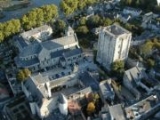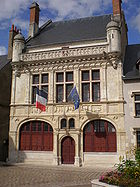
Beaugency
Encyclopedia
Beaugency is a commune
in the Loiret
department in north-central France
. It is located on the Loire river, upriver (northeast) from Blois and downriver from Orléans
.
to the Crown. Afterward it passed to the house of Orléans, then to those of Dunois
and Longueville, and ultimately again to that of Orléans.
The city of Beaugency has been the site of numerous military conflicts. It was occupied on four separate occasions by the English. On June 16 – 17, 1429, it was the site of the famous Battle of Beaugency, when it was freed by Joan of Arc
. Beaugency also played an important strategic role in the Hundred Years' War
. It was burned by the Protestants in 1567 and suffered extensive damage to the walls, the castle, and the church.
On the 8th, 9th and 10th of December 1870, the Prussian army, commanded by the grand-duke of Mecklenburg, defeated the French army of the Loire, under General Chanzy, in the second battle of Beaugency
(or Villorceau-Josnes). It was fought on the right bank of the Loire to the northwest of Beaugency.
In 1940 and again in 1944, the city was bombed by Nazi Germany. On 16 September 1944, German Major General Botho Henning Elster and his 18 850 men and 754 officers surrendered at the Loire bridge of Beaugency to U.S. Major General Robert C. Macon
of the 83rd Infantry Division
.
.

Communes of France
The commune is the lowest level of administrative division in the French Republic. French communes are roughly equivalent to incorporated municipalities or villages in the United States or Gemeinden in Germany...
in the Loiret
Loiret
Loiret is a department in north-central FranceThe department is named after the river Loiret, a tributary of the Loire. The Loiret is located wholly within the department.- History :...
department in north-central France
France
The French Republic , The French Republic , The French Republic , (commonly known as France , is a unitary semi-presidential republic in Western Europe with several overseas territories and islands located on other continents and in the Indian, Pacific, and Atlantic oceans. Metropolitan France...
. It is located on the Loire river, upriver (northeast) from Blois and downriver from Orléans
Orléans
-Prehistory and Roman:Cenabum was a Gallic stronghold, one of the principal towns of the Carnutes tribe where the Druids held their annual assembly. It was conquered and destroyed by Julius Caesar in 52 BC, then rebuilt under the Roman Empire...
.
History
The lords of Beaugency attained considerable importance in the 11th, 12th and 13th centuries; at the end of the 13th century they sold the fiefdomFiefdom
A fee was the central element of feudalism and consisted of heritable lands granted under one of several varieties of feudal tenure by an overlord to a vassal who held it in fealty in return for a form of feudal allegiance and service, usually given by the...
to the Crown. Afterward it passed to the house of Orléans, then to those of Dunois
Jean de Dunois
John of Orléans, Count of Dunois was the illegitimate son of Louis d'Orléans by Mariette d'Enghien.The term "Bastard of Orléans" John of Orléans, Count of Dunois (French born "Jean Levieux Valois des Orléans" better known as Jean d'Orléans, comte de Dunois, also known as John of Orléans and...
and Longueville, and ultimately again to that of Orléans.
The city of Beaugency has been the site of numerous military conflicts. It was occupied on four separate occasions by the English. On June 16 – 17, 1429, it was the site of the famous Battle of Beaugency, when it was freed by Joan of Arc
Joan of Arc
Saint Joan of Arc, nicknamed "The Maid of Orléans" , is a national heroine of France and a Roman Catholic saint. A peasant girl born in eastern France who claimed divine guidance, she led the French army to several important victories during the Hundred Years' War, which paved the way for the...
. Beaugency also played an important strategic role in the Hundred Years' War
Hundred Years' War
The Hundred Years' War was a series of separate wars waged from 1337 to 1453 by the House of Valois and the House of Plantagenet, also known as the House of Anjou, for the French throne, which had become vacant upon the extinction of the senior Capetian line of French kings...
. It was burned by the Protestants in 1567 and suffered extensive damage to the walls, the castle, and the church.
On the 8th, 9th and 10th of December 1870, the Prussian army, commanded by the grand-duke of Mecklenburg, defeated the French army of the Loire, under General Chanzy, in the second battle of Beaugency
Battle of Beaugency (1870)
The Battle of Beaugency was a battle of the Franco-Prussian War contested between the army group of the Grand Duke of Mecklenburg, and the French Armée de la Loire, won by the Prussians. It lasted from 8 to 10 December 1870 and occurred on the left bank of the Loire River to the northwest of the...
(or Villorceau-Josnes). It was fought on the right bank of the Loire to the northwest of Beaugency.
In 1940 and again in 1944, the city was bombed by Nazi Germany. On 16 September 1944, German Major General Botho Henning Elster and his 18 850 men and 754 officers surrendered at the Loire bridge of Beaugency to U.S. Major General Robert C. Macon
Robert C. Macon
Robert Chauncey Macon was a general in the United States Army during World War II. He commanded the 83rd Infantry Division during the drive across Europe and later served as military attaché in Moscow.-Early life:...
of the 83rd Infantry Division
U.S. 83rd Infantry Division
The 83rd Infantry Division was a formation of the United States Army in World War I and World War II.-World War I:The division was activated in September 1917, and went overseas in June 1918. It was designated a depot division. Thus it supplied over 195,000 officers and enlisted men as...
.
Economy
Until 1846 Beaugency was an important commercial center due to trade along the Loire. After trade moved from the river to rail traffic, the city's role changed. Beaugency became a market center for the surrounding agricultural district. Today Beaugency's economy depends largely on tourismTourism
Tourism is travel for recreational, leisure or business purposes. The World Tourism Organization defines tourists as people "traveling to and staying in places outside their usual environment for not more than one consecutive year for leisure, business and other purposes".Tourism has become a...
.
Sights
- Medieval keep (11th century) 47°46′39"N 1°37′59"E
- Lock of Dunois (14-15th century)
- Church Saint Etienne (11th century)
- Abbey church (12th century)
- City hall (16th century)
- Bridge (14th century)


